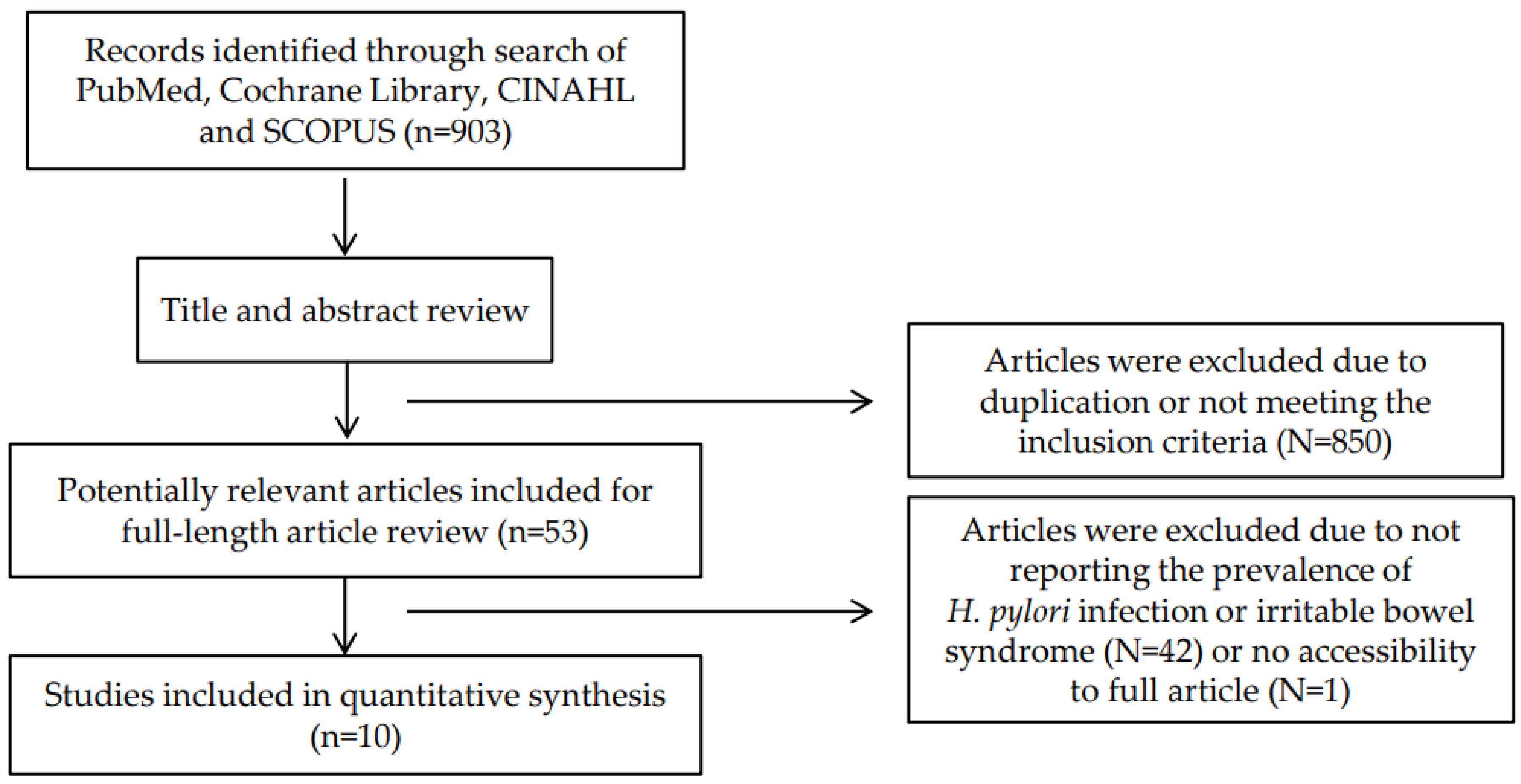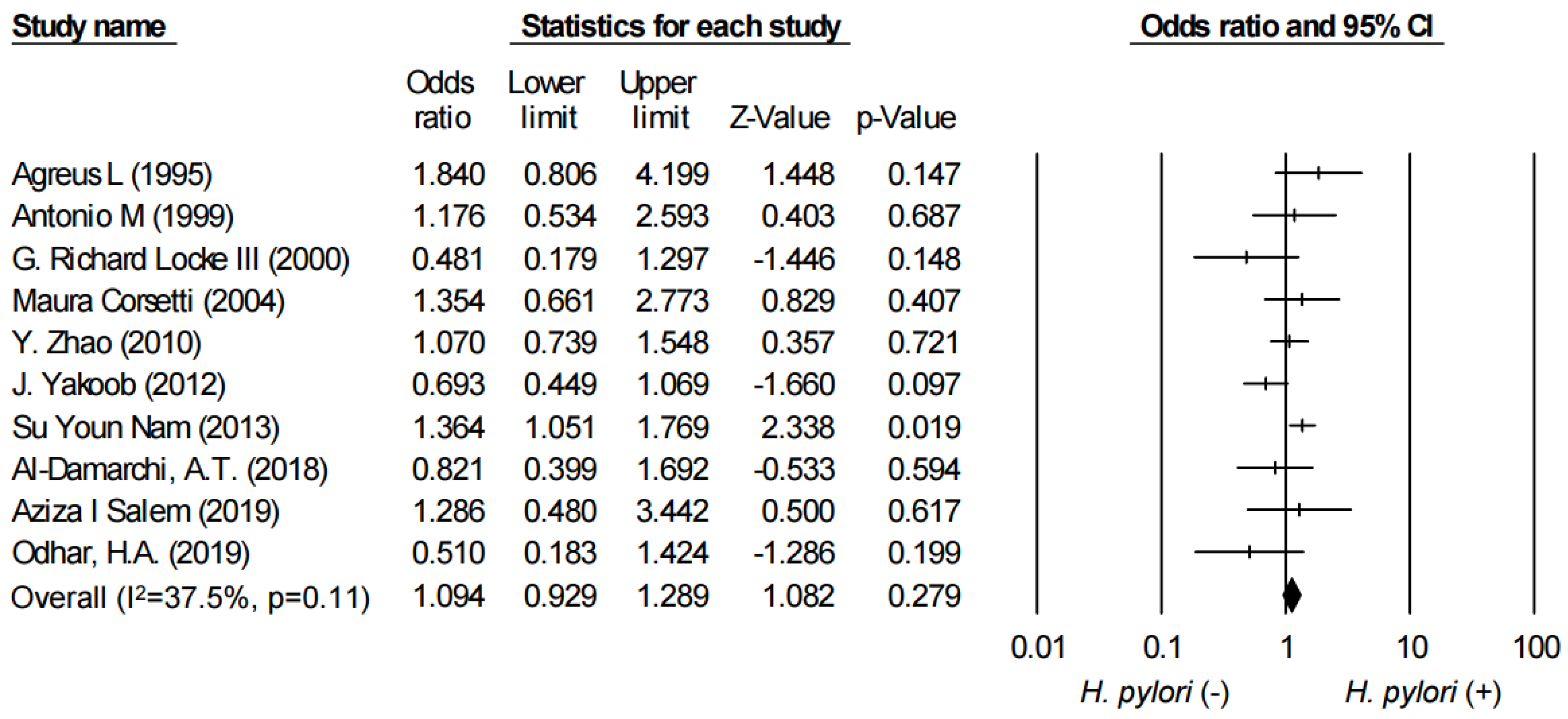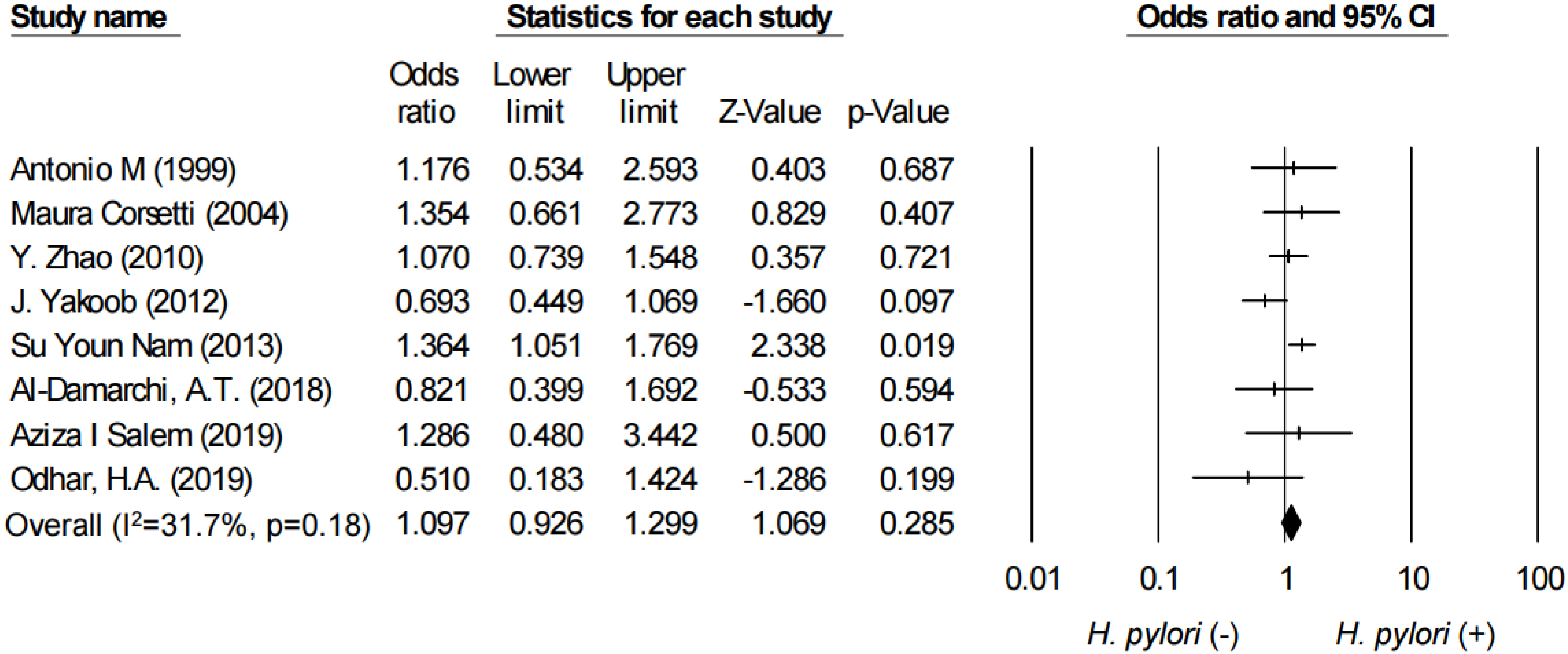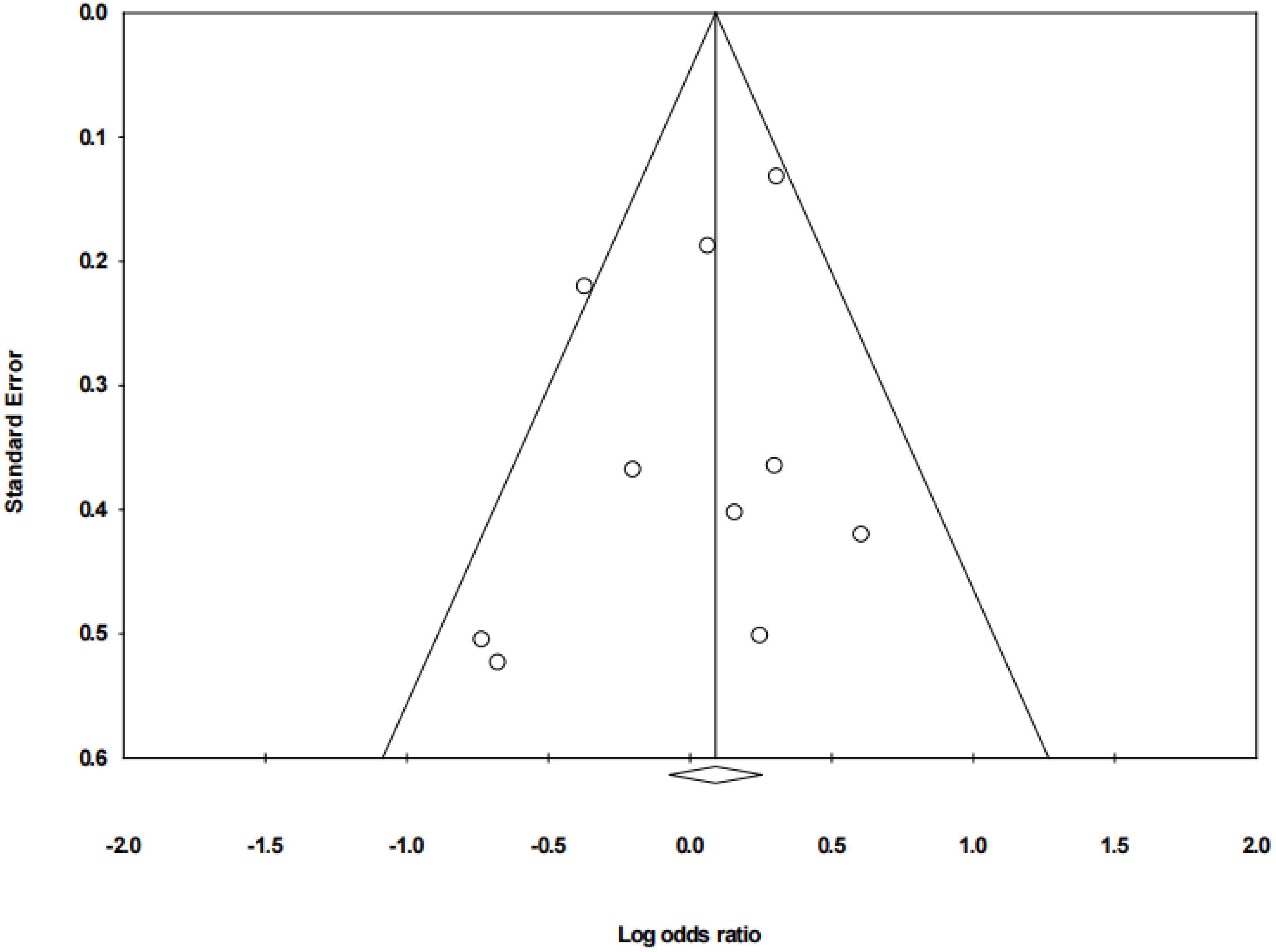The Association between Helicobacter pylori Infection and Irritable Bowel Syndrome: A Meta-Analysis
Abstract
1. Introduction
2. Materials and Methods
2.1. Literature Search
2.2. Inclusion Criteria and Exclusion Criteria
- Study population including patients with IBS regardless of diagnostic methods;
- Studies which evaluated H. pylori infection among study populations regardless of detection methods;
- Study design: cross-sectional studies, case-control studies and cohort studies.
- In vitro studies;
- Abstracts, review articles, letters, and case reports;
- Studies in which the subjects were children.
2.3. Data Extraction and Quality Evaluation
2.4. Quality Assessment
2.5. Statistical Analyses
3. Results
3.1. Characteristics of Eligible Studies
3.2. Irritable Bowel Syndrome and H. pylori Infection
3.3. Subgroup Analysis
3.4. Evaluation for Publication Bias
4. Discussion
5. Conclusions
Author Contributions
Funding
Conflicts of Interest
References
- Drossman, D.A. The functional gastrointestinal disorders and the Rome III process. Gastroenterology 2006, 130, 1377–1390. [Google Scholar] [CrossRef] [PubMed]
- Sultan, S.; Malhotra, A. Irritable bowel syndrome. Ann. Intern. Med. 2017, 166, ITC81–ITC96. [Google Scholar] [CrossRef] [PubMed]
- Adriani, A.; Ribaldone, D.G.; Astegiano, M.; Durazzo, M.; Saracco, G.M.; Pellicano, R. Irritable bowel syndrome: The clinical approach. Panminerva Medica 2018, 60, 213–222. [Google Scholar] [CrossRef] [PubMed]
- Park, K.S.; Ahn, S.H.; Hwang, J.S.; Cho, K.B.; Chung, W.J.; Jang, B.K.; Kang, Y.N.; Kwon, J.H.; Kim, Y.H. A survey about irritable bowel syndrome in South Korea: Prevalence and observable organic abnormalities in IBS patients. Dig. Dis. Sci. 2008, 53, 704–711. [Google Scholar] [CrossRef] [PubMed]
- Ford, A.C.; Lacy, B.E.; Talley, N.J. Irritable bowel syndrome. N. Engl. J. Med. 2017, 376, 2566–2578. [Google Scholar] [CrossRef] [PubMed]
- Whitehead, W.E.; Burnett, C.K.; Cook, E.W., III; Taub, E. Impact of irritable bowel syndrome on quality of life. Dig. Dis. Sci. 1996, 41, 2248–2253. [Google Scholar] [CrossRef]
- Creed, F.; Ratcliffe, J.; Fernandez, L.; Tomenson, B.; Palmer, S.; Rigby, C.; Guthrie, E.; Read, N.; Thompson, D. Health-related quality of life and health care costs in severe, refractory irritable bowel syndrome. Ann. Intern. Med. 2001, 134 Pt 2, 860–868. [Google Scholar] [CrossRef]
- McColl, K.E. Clinical practice. Helicobacter pylori infection. N. Engl. J. Med. 2010, 362, 1597–1604. [Google Scholar] [CrossRef]
- Bang, C.S.; Baik, G.H. Helicobacter pylori infection and related gastrointestinal diseases. Korean J. Med. 2015, 89, 142–148. [Google Scholar] [CrossRef]
- Pellicano, R.; Ménard, A.; Rizzetto, M.; Mégraud, F. Helicobacter species and liver diseases: Association or causation? Lancet Infect. Dis. 2008, 8, 254–260. [Google Scholar] [CrossRef]
- Yang, F.; Xu, Y.L.; Zhu, R.F. Helicobacter pylori infection and the risk of colorectal carcinoma: A systematic review and meta-analysis. Minerva Medica 2019, 110, 464–470. [Google Scholar] [CrossRef] [PubMed]
- Armstrong, D. Helicobacter pylori infection and dyspepsia. Scand. J. Gastroenterol. Suppl. 1996, 215, 38–47. [Google Scholar] [CrossRef] [PubMed]
- Jin, X.; Li, Y.M. Systematic review and meta-analysis from Chinese literature: The association between Helicobacter pylori eradication and improvement of functional dyspepsia. Helicobacter 2007, 12, 541–546. [Google Scholar] [CrossRef] [PubMed]
- Perri, F.; Clemente, R.; Festa, V.; Annese, V.; Quitadamo, M.; Rutgeerts, P.; Andriulli, A. Patterns of symptoms in functional dyspepsia: Role of Helicobacter pylori infection and delayed gastric emptying. Am. J. Gastroenterol. 1998, 93, 2082–2088. [Google Scholar] [CrossRef] [PubMed]
- Choi, Y.J.; Kim, N.; Yoon, H.; Shin, C.M.; Park, Y.S.; Kim, J.W.; Kim, Y.S.; Lee, D.H.; Jung, H.C. Overlap between irritable bowel syndrome and functional dyspepsia including subtype analyses. J. Gastroenterol. Hepatol. 2017, 32, 1553–1561. [Google Scholar] [CrossRef]
- Yakoob, J.; Abbas, Z.; Naz, S.; Islam, M.; Jafri, W. Virulence markers of Helicobacter pylori in patients with diarrhoea-dominant irritable bowel syndrome. Br. J. Biomed. Sci. 2012, 69, 6–10. [Google Scholar] [CrossRef]
- Gerards, C.; Leodolter, A.; Glasbrenner, B.; Malfertheiner, P. H. pylori infection and visceral hypersensitivity in patients with irritable bowel syndrome. Dig. Dis. 2001, 19, 170–173. [Google Scholar] [CrossRef]
- Xiong, F.; Xiong, M.; Ma, Z.; Huang, S.; Li, A.; Liu, S. Lack of Association found between Helicobacter pylori infection and diarrhea-predominant irritable bowel syndrome: A multicenter retrospective study. Gastroenterol. Res. Pract. 2016, 2016, 3059201. [Google Scholar] [CrossRef]
- Locke, C.R., III; Talley, N.J.; Nelson, D.K.; Haruma, K.; Weaver, A.L.; Zinsmeister, A.R.; Melton, L.J., III. Helicobacter pylori and dyspepsia: A population-based study of the organism and host. Am. J. Gastroenterol. 2000, 95, 1906–1913. [Google Scholar] [CrossRef]
- Zhang, L.; Day, A.; McKenzie, G.; Mitchell, H. Nongastric Helicobacter species detected in the intestinal tract of children. J. Clin. Microbiol. 2006, 44, 2276–2279. [Google Scholar] [CrossRef]
- Zhao, Y.; Zou, D.; Wang, R.; Ma, X.; Yan, X.; Man, X.; Gao, L.; Fang, J.; Yan, H.; Kang, X.; et al. Dyspepsia and irritable bowel syndrome in China: A population-based endoscopy study of prevalence and impact. Aliment. Pharmacol. Ther. 2010, 32, 562–572. [Google Scholar] [CrossRef] [PubMed]
- Nam, S.Y.; Ryu, K.H.; Park, B.J. Irritable bowel syndrome is associated with gastroesophageal reflux symptom but not erosive esophagitis. J. Neurogastroenterol. Motil. 2013, 19, 521–531. [Google Scholar] [CrossRef] [PubMed]
- Ford, A.C.; Forman, D.; Bailey, A.G.; Axon, A.T.; Moayyedi, P. Irritable bowel syndrome: A 10-yr natural history of symptoms and factors that influence consultation behavior. Am. J. Gastroenterol. 2008, 103, 1229–1239. [Google Scholar] [CrossRef] [PubMed]
- Ford, A.C.; Forman, D.; Bailey, A.G.; Axon, A.T.; Moayyedi, P. Initial poor quality of life and new onset of dyspepsia: Results from a longitudinal 10-year follow-up study. Gut 2007, 56, 321–327. [Google Scholar] [CrossRef]
- Higgins, J.P.; Thompson, S.G.; Deeks, J.J.; Altman, D.G. Measuring inconsistency in meta-analyses. BMJ 2003, 327, 557–560. [Google Scholar] [CrossRef]
- Easterbrook, P.J.; Berlin, J.A.; Gopalan, R.; Matthews, D.R. Publication bias in clinical research. Lancet 1991, 337, 867–872. [Google Scholar] [CrossRef]
- Agreus, L.; Engstrand, L.; Svardsudd, K.; Nyren, O.; Tibblin, G. Helicobacter pylori seropositivity among Swedish adults with and without abdominal symptoms. A population-based epidemiologic study. Scand. J. Gastroenterol. 1995, 30, 752–757. [Google Scholar] [CrossRef]
- Caballero-Plasencia, A.M.; Valenzuela-Barranco, M.; Herrerías-Gutiérrez, J.M.; Esteban-Carretero, J.M. Altered gastric emptying in patients with irritable bowel syndrome. Eur. J. Nucl. Med. 1999, 26, 404–409. [Google Scholar] [CrossRef]
- Corsetti, M.; Caenepeel, P.; Fischler, B.; Janssens, J.; Tack, J. Impact of coexisting irritable bowel syndrome on symptoms and pathophysiological mechanisms in functional dyspepsia. Am. J. Gastroenterol. 2004, 99, 1152–1159. [Google Scholar] [CrossRef]
- Al-Damarchi, A.T.; Al-Talakani, G.A. Association of helicobacter pylori and irritable bowel syndrome. Indian J. Public Health Res. Dev. 2018, 9, 486–491. [Google Scholar] [CrossRef]
- Salem, A.I.; El-Taweel, H.A.; Madkour, M.A.; Abd El-Latif, N.F.; Abd-Elrazeq, E.S. Irritable bowel syndrome in Egyptian patients: Plausible risk factors and association with intestinal protozoa. Trop. Dr. 2019, 49, 184–188. [Google Scholar] [CrossRef] [PubMed]
- Odhar, H.A.; Hashim, A.F.; Obaid, D.H.; Majeed, R.S.; Habeeb, O.A.; Abdalhadi, N.M. Exploration of potential link between prevalence of irritable bowel syndrome and seropositivity for Helicobacter pylori. Indian J. Public Health Res. Dev. 2019, 10, 2236–2240. [Google Scholar] [CrossRef]
- Ng, Q.X.; Foo, N.X.; Loke, W.; Koh, Y.Q.; Seah, V.J.M.; Soh, A.Y.S.; Yeo, W.S. Is there an association between Helicobacter pylori infection and irritable bowel syndrome? A meta-analysis. World J. Gastroenterol. 2019, 25, 5702–5710. [Google Scholar] [CrossRef]
- Malfertheiner, P.; Megraud, F.; O’Morain, C.A.; Atherton, J.; Axon, A.T.; Bazzoli, F.; Gensini, G.F.; Gisbert, J.P.; Graham, D.Y.; Rokkas, T.; et al. Management of Helicobacter pylori infection—The Maastricht IV/Florence Consensus Report. Gut 2012, 61, 646–664. [Google Scholar] [CrossRef]
- Moayyedi, P.; Soo, S.; Deeks, J.; Forman, D.; Mason, J.; Innes, M.; Delaney, B. Systematic review and economic evaluation of Helicobacter pylori eradication treatment for non-ulcer dyspepsia. Dyspepsia Review Group. BMJ 2000, 321, 659–664. [Google Scholar] [CrossRef] [PubMed][Green Version]
- Su, Y.C.; Wang, W.M.; Wang, S.Y.; Lu, S.N.; Chen, L.T.; Wu, D.C.; Chen, C.Y.; Jan, C.M.; Horowitz, M. The association between Helicobacter pylori infection and functional dyspepsia in patients with irritable bowel syndrome. Am. J. Gastroenterol. 2000, 95, 1900–1905. [Google Scholar] [CrossRef]
- Jaakkimainen, R.L.; Boyle, E.; Tudiver, F. Is Helicobacter pylori associated with non-ulcer dyspepsia and will eradication improve symptoms? A meta-analysis. BMJ 1999, 319, 1040–1044. [Google Scholar] [CrossRef]
- Moayyedi, P.; Lacy, B.E.; Andrews, C.N.; Enns, R.A.; Howden, C.W.; Vakil, N. ACG and CAG clinical guideline: Management of dyspepsia. Am. J. Gastroenterol. 2017, 112, 988–1013. [Google Scholar] [CrossRef]
- Talley, N.J.; Ford, A.C. Functional dyspepsia. N. Engl. J. Med. 2015, 373, 1853–1863. [Google Scholar] [CrossRef]
- Stanghellini, V. Functional dyspepsia and irritable bowel syndrome: Beyond Rome IV. Dig. Dis. 2017, 35 (Suppl. S1), 14–17. [Google Scholar] [CrossRef] [PubMed]
- Ford, A.C.; Marwaha, A.; Lim, A.; Moayyedi, P. Systematic review and meta-analysis of the prevalence of irritable bowel syndrome in individuals with dyspepsia. Clin. Gastroenterol. Hepatol. Off. Clin. Pract. J. Am. Gastroenterol. Assoc. 2010, 8, 401–409. [Google Scholar] [CrossRef] [PubMed]
- Keely, S.; Walker, M.M.; Marks, E.; Talley, N.J. Immune dysregulation in the functional gastrointestinal disorders. Eur. J. Clin. Investig. 2015, 45, 1350–1359. [Google Scholar] [CrossRef] [PubMed]
- Simren, M.; Palsson, O.S.; Whitehead, W.E. Update on Rome IV Criteria for Colorectal Disorders: Implications for Clinical Practice. Curr. Gastroenterol. Rep. 2017, 19, 15. [Google Scholar] [CrossRef] [PubMed]
- Ghoshal, U.C.; Abraham, P.; Bhatia, S.J.; Misra, S.P.; Choudhuri, G.; Biswas, K.D.; Chakravartty, K.; Dadhich, S.; Goswami, B.D.; Jayanthi, V.; et al. Comparison of Manning, Rome I, II, and III, and Asian diagnostic criteria: Report of the Multicentric Indian Irritable Bowel Syndrome (MIIBS) study. Indian J. Gastroenterol. Off. J. Indian Soc. Gastroenterol. 2013, 32, 369–375. [Google Scholar] [CrossRef]




| Author | Year | Country | Design | H. pylori Diagnostic Method | IBS Diagnostic Criteria | Sample Size (Total No. of Study Participants) | No. of IBS | No. of Control | No. of H. pylori (+) in IBS Group | No. of H. pylori (+) in Control Group | Male (%) | Mean Age ± SD or Median Age (Range) | Quality Assessment (Newcastle-Ottawa Scale) |
|---|---|---|---|---|---|---|---|---|---|---|---|---|---|
| Agreus L [27] | 1995 | Sweden | Case-control | ELISA (Antibody-IgG for H. pylori) | Diagnostic criteria developed by authors | 150 | 50 | 50 | 16 | 23 | 36 | 48 (22–80) | S2, C0, E2 |
| Antonio M [28] | 1999 | Spain | Case-control | Antibody-IgG for H. pylori | Rome criteria | 100 | 50 | 50 | 27 | 29 | 50 | 34.1 ± 7.4 in IBS, 35.6 ± 5.6 in control | S2, C1, E2 |
| G. Richard Locke III [19] | 2000 | USA | Cross-sectional | ELISA (Antibody-IgG for H. pylori) | Manning et al. | 148 | 35 | 77 | 9 | 11 | 42 | 31 (20–50) | S3, C2, O3 |
| Maura Corsetti [29] | 2004 | Belgium | Cross-sectional | Endoscopic biopsy and stain | Rome Ⅱ | 309 | 144 | 165 | 14 | 21 | 33 | 42.0 ± 0.8 | S2, C0, O3 |
| Y. Zhao [21] | 2010 | China | Cross-sectional | ELISA (Antibody-IgG for H. pylori) | Rome Ⅱ | 3148 | 147 | 3001 | 106 | 2204 | 47.8 | 42.5 ± 15.2 | S4, C2, O3 |
| J. Yakoob [16] | 2012 | Pakistan | Case-control | Endoscopic biopsy | Rome Ⅲ | 330 | 170 | 160 | 91 | 71 | 69 in IBS, 66 in control | 40 ± 15 in IBS, 42 ± 14 in control | S2, C0, O3 |
| Su Youn Nam [22] | 2013 | Korea | Cross-sectional | Endoscopic biopsy, UBT | Rome Ⅲ | 2769 | 258 | 2511 | 106 | 1224 | 65.5 in IBS, 60.3 in control | 45.3 ± 8.6 in IBS, 50.2 ± 9.9 in control | S3, C2, O3 |
| Al-Damarchi, A.T [30] | 2018 | Iraq | Case-control | H. pylori stool antigen test | Rome Ⅳ | 135 | 60 | 75 | 21 | 23 | 22 in IBS, 42 in control | 33.5 ± 2.5 in IBS, 34.8 ± 3.1 in control | S2, C1, E1 |
| Aziza I Salem [31] | 2019 | Egypt | Case-control | H. pylori Ag ELISA | Rome III | 120 | 40 | 40 | 10 | 12 | NA | 28 ± 9.5 in IBS, 33.5 ± 13.9 in control | S2, C2, E2 |
| Odhar, H.A. [32] | 2019 | Iraq | Case-control | Antibody-IgG for H. pylori | Rome Ⅳ | 60 | 30 | 30 | 17 | 12 | 20 in IBS, 53.3 in control | 23 (19–50) in IBS, 23 (19–55) in control | S2, C1, E1 |
© 2020 by the authors. Licensee MDPI, Basel, Switzerland. This article is an open access article distributed under the terms and conditions of the Creative Commons Attribution (CC BY) license (http://creativecommons.org/licenses/by/4.0/).
Share and Cite
Kim, Y.-A.; Cho, Y.J.; Kwak, S.G. The Association between Helicobacter pylori Infection and Irritable Bowel Syndrome: A Meta-Analysis. Int. J. Environ. Res. Public Health 2020, 17, 2524. https://doi.org/10.3390/ijerph17072524
Kim Y-A, Cho YJ, Kwak SG. The Association between Helicobacter pylori Infection and Irritable Bowel Syndrome: A Meta-Analysis. International Journal of Environmental Research and Public Health. 2020; 17(7):2524. https://doi.org/10.3390/ijerph17072524
Chicago/Turabian StyleKim, Yun-A, Yoon Jeong Cho, and Sang Gyu Kwak. 2020. "The Association between Helicobacter pylori Infection and Irritable Bowel Syndrome: A Meta-Analysis" International Journal of Environmental Research and Public Health 17, no. 7: 2524. https://doi.org/10.3390/ijerph17072524
APA StyleKim, Y.-A., Cho, Y. J., & Kwak, S. G. (2020). The Association between Helicobacter pylori Infection and Irritable Bowel Syndrome: A Meta-Analysis. International Journal of Environmental Research and Public Health, 17(7), 2524. https://doi.org/10.3390/ijerph17072524





